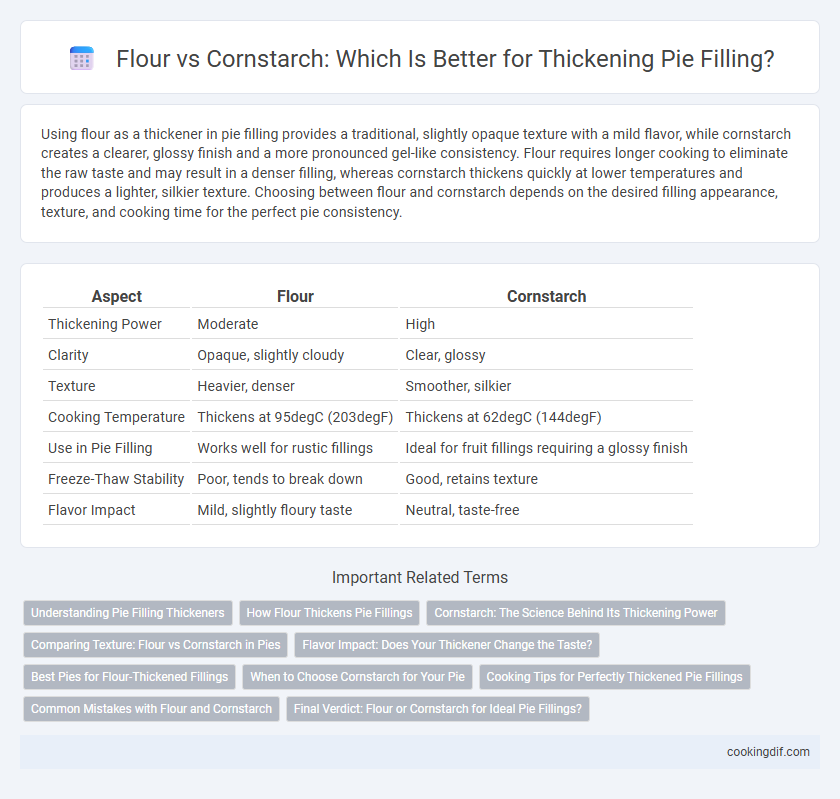Using flour as a thickener in pie filling provides a traditional, slightly opaque texture with a mild flavor, while cornstarch creates a clearer, glossy finish and a more pronounced gel-like consistency. Flour requires longer cooking to eliminate the raw taste and may result in a denser filling, whereas cornstarch thickens quickly at lower temperatures and produces a lighter, silkier texture. Choosing between flour and cornstarch depends on the desired filling appearance, texture, and cooking time for the perfect pie consistency.
Table of Comparison
| Aspect | Flour | Cornstarch |
|---|---|---|
| Thickening Power | Moderate | High |
| Clarity | Opaque, slightly cloudy | Clear, glossy |
| Texture | Heavier, denser | Smoother, silkier |
| Cooking Temperature | Thickens at 95degC (203degF) | Thickens at 62degC (144degF) |
| Use in Pie Filling | Works well for rustic fillings | Ideal for fruit fillings requiring a glossy finish |
| Freeze-Thaw Stability | Poor, tends to break down | Good, retains texture |
| Flavor Impact | Mild, slightly floury taste | Neutral, taste-free |
Understanding Pie Filling Thickeners
Flour and cornstarch serve as common thickeners for pie filling, each affecting texture and clarity differently. Flour creates a denser, more opaque filling with a slightly cloudy appearance, ideal for fruit pies that benefit from a hearty consistency. Cornstarch produces a smoother, clearer filling with a glossy finish, enhancing the visual appeal of delicate or custard-style pies.
How Flour Thickens Pie Fillings
Flour thickens pie fillings by absorbing liquid and swelling during cooking, creating a smooth, opaque texture that holds its shape well. Its starch granules gelatinize at higher temperatures, providing a slightly denser consistency ideal for fruit fillings that require extended baking times. Using flour results in a more stable filling with a traditional mouthfeel, but may produce less clarity and gloss compared to cornstarch.
Cornstarch: The Science Behind Its Thickening Power
Cornstarch thickens pie fillings through gelatinization, where heat causes starch granules to absorb water and swell, creating a smooth, glossy texture. It typically requires less quantity than flour for the same thickening effect, resulting in a clearer, more translucent filling ideal for fruit pies. The high amylopectin content in cornstarch makes it especially effective at producing a stable, velvety consistency without the cloudiness often associated with flour-based thickeners.
Comparing Texture: Flour vs Cornstarch in Pies
Flour creates a dense and hearty pie filling with a slightly opaque appearance, while cornstarch yields a clearer, glossy finish with a lighter, more delicate texture. Flour thickens pie fillings more gradually and can impart a slight doughy taste if overcooked, whereas cornstarch thickens rapidly at lower temperatures and maintains a neutral flavor. For fruit pies requiring a tender, gel-like consistency, cornstarch is preferred, whereas flour is better suited for custard or cream fillings demanding a sturdier base.
Flavor Impact: Does Your Thickener Change the Taste?
Flour adds a subtle, slightly toasted flavor to pie fillings, enriching the overall taste with a mild, buttery note. Cornstarch provides a more neutral flavor, allowing the natural fruit or other ingredients to shine without altering the filling's inherent taste. Choosing between flour and cornstarch depends on whether you prefer a thicker texture with a richer flavor or a clear, glossy finish that highlights the filling's original flavor.
Best Pies for Flour-Thickened Fillings
Flour-thickened pie fillings offer a classic, hearty texture ideal for fruit pies like apple and cherry, where a slightly opaque, rich consistency complements the natural sweetness. Using flour requires longer cooking to eliminate the raw taste, resulting in a more stable filling that holds its shape well during slicing and serving. Pies such as peach, blueberry, and mixed berry varieties benefit from flour's ability to absorb juices and prevent overly runny fillings, enhancing overall sliceability and presentation.
When to Choose Cornstarch for Your Pie
Cornstarch is ideal for pie fillings that require a clear, glossy finish, such as fruit pies with stay-in-shape textures like cherry or blueberry. It thickens at a lower temperature and creates a smooth, jelly-like consistency without cloudiness, making it perfect when visual appeal is essential. Choose cornstarch when you want a lighter, more transparent filling that holds well but doesn't become overly thick or heavy.
Cooking Tips for Perfectly Thickened Pie Fillings
Flour offers a more opaque and slightly denser texture to pie fillings, creating a traditional, hearty consistency ideal for fruit pies like apple or cherry. Cornstarch provides a clearer, glossy finish and a smoother texture, setting quickly and holding up well in acidic fillings such as berry or lemon pies. For perfectly thickened pie fillings, combine precise measurements with gradual cooking over medium heat, stirring constantly until the mixture thickens to avoid lumps and ensure even texture.
Common Mistakes with Flour and Cornstarch
Using too much flour can result in a gritty texture and a cloudy, dull appearance in pie filling, while insufficient flour may cause it to remain runny. Cornstarch thickens more quickly and produces a glossy, translucent finish but overheating can lead to a breakdown, thinning the filling. Common mistakes include not mixing flour thoroughly to avoid lumps and adding cornstarch directly to hot liquid, which causes clumping instead of smooth thickening.
Final Verdict: Flour or Cornstarch for Ideal Pie Fillings?
Cornstarch creates a crystal-clear, glossy pie filling with a smooth texture, ideal for fruit pies that require a translucent finish, while flour results in a more opaque and slightly cloudy appearance with a denser texture. For fillings that need a firmer hold and less sweetness, flour provides reliable thickening but may mask the natural fruit flavors more than cornstarch. Cornstarch is the preferred choice for achieving a perfectly set, visually appealing pie filling that balances consistency and flavor clarity.
Thickening with flour vs cornstarch for pie filling Infographic

 cookingdif.com
cookingdif.com